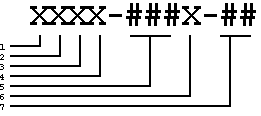F-16 Reference
US Tri-Service Designation System Guided Missiles |
Introduction
In 1962, the US Military adopted the so-called "Tri-Service" designation system, which is still used today. Under the system, the three services (USAF, USN and USMC) were to use common designations for aircraft, guided missiles and electronic equipment. The conventions are described in the DEPARTMENT OF DEFENSE PUBLICATION 4120.15-L and are officially known as the MDS (MISSION, DESIGN, AND SERIES SYSTEM). Below are the details of the designation system for guided missiles:
General Format
A typical Guided Missile designation has the following format:
with X for an arbitrary letter and the hash-mark for an arbitrary digit. Not all letters or digits are necessarily used. All characters have a special signification, according to their position in the designation (The numbers of the sections below correspond with the numbers in the figure above):
1. Status Prefix (Rarily Used)
Indicates any special modifications that have been made to the missile.
| Prefix | Status |
|---|---|
| C | Captive |
| D | Dummy |
| J | Special Test Temporary |
| M | Modified |
| N | Special Test Permanent |
| X | Experimental |
| Y | Prototype |
| Z | Planning |
2. Launch Environment
Indicates the type(s) of launching platform(s).
| Prefix | Launch Environment |
|---|---|
| A | Air |
| B | Multiple |
| C | Coffin |
| F | Individual |
| G | Runway |
| H | Silo Stored |
| L | Silo Launched |
| M | Mobile |
| P | Soft PAD |
| R | Ship |
| S | Space |
| U | Underwater |
3. Basic Mission
Indicates the primary task for which the vehicle was designed.
| Prefix | Basic Mission |
|---|---|
| C | Cargo / Transport |
| D | Decoy |
| E | Electronic / Communications |
| G | Surface Attack |
| I | Intercept Arial or Space |
| L | Launch Detection / Surveillance |
| M | Scientific / Calibration |
| N | Navigation |
| Q | Drone |
| S | Space Support |
| T | Training |
| U | Underwater Attack |
| W | Weather |
4. Vehicle Type
Indicates the type of vehicle.
| Prefix | Vehicle Type |
|---|---|
| B | Booster |
| M | Guided Missile or Drone |
| N | Probe |
| R | Rocket |
| S | Satellite |
5. Design Number
Supposedly in sequential order, it indicates the model of the vehicle within the basic mission category6. Series
Indicates (alphabetically) major modifications to the original design, which is indicated by the A. I and O are usually skipped in order to avoid confusion with the 1 and the 0.7.Configuration Number
Indicates a minor modification.Example
The AIM-9P-4 is an air-launched intercept missile, model nr.9, modification P, and submodification 4.
Errors and Omissions
Please use this form to add any list any error or omissions you find in the above text.
Note: your comments will be displayed immediately on this page. If you wish to send a private comment to the webmasters, please use the Contact Us link.
